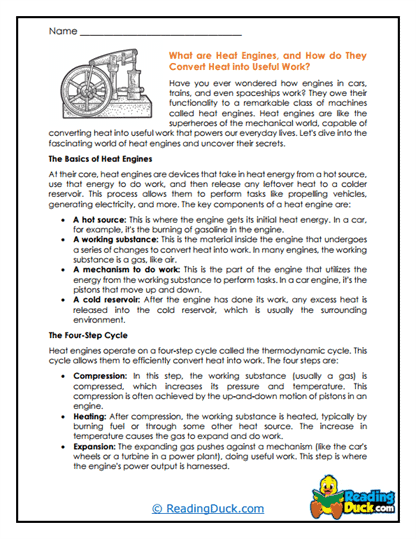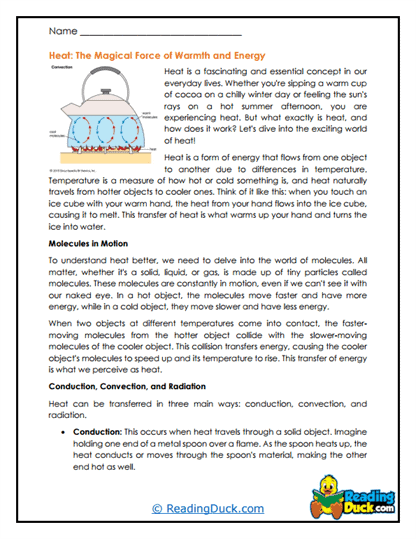Heat Worksheets
About Our Heat Worksheets
Our Heat worksheets provide a comprehensive exploration of the concept of heat, an essential topic within the study of Physics. This collection is designed to help students understand the principles of heat transfer, the relationship between heat and temperature, and the role of heat in everyday phenomena. Each worksheet set within this collection is structured to engage students through a combination of informative reading passages, thought-provoking questions, and visually appealing images.
Each worksheet set includes:
- Multiple Choice Questions: These questions test students' comprehension of the reading passage, reinforcing key concepts and ensuring they can recall important information.
- Short Answer Questions: These prompts require students to explain concepts in their own words, deepening their understanding and encouraging them to articulate their thoughts clearly.
- Open-Ended Questions: These questions invite students to reflect on the material, express their opinions, and make connections to real-world applications, fostering critical thinking and personal engagement with the topic.
Each question sheet comes with an answer key, making it easier for teachers and parents to guide students. The worksheets are available as easily accessible PDF files, which can be viewed electronically, downloaded, and printed out for use in any educational setting.
Understanding Heat: The Invisible Energy at Work
Heat is a form of energy that plays a crucial role in our everyday lives. From cooking food to keeping us warm in winter, heat is involved in countless processes that we often take for granted. Understanding the principles of heat and how it transfers from one object to another is fundamental in Physics and has practical applications in many fields, including engineering, meteorology, and environmental science.
1. What is Heat?
- Definition of Heat:
- Heat is a form of energy that is transferred between objects due to a temperature difference. When two objects at different temperatures come into contact, heat flows from the hotter object to the cooler one until thermal equilibrium is reached.
- Temperature vs. Heat:
- It's important to differentiate between heat and temperature. Temperature is a measure of the average kinetic energy of the particles in a substance, while heat is the total energy transferred due to a difference in temperature. Understanding this distinction helps students grasp why an object with a higher temperature does not always contain more heat.
2. Methods of Heat Transfer
- Conduction:
- Conduction is the transfer of heat through direct contact between molecules. This process occurs primarily in solids, where particles are closely packed together. An example of conduction is when a metal spoon gets hot after being left in a pot of boiling water. Students can explore how different materials conduct heat at different rates.
- Convection:
- Convection is the transfer of heat through the movement of fluids (liquids and gases). Warm fluid rises while cooler fluid sinks, creating a convection current. This process is responsible for many natural phenomena, such as wind patterns and ocean currents. Understanding convection helps students see how heat transfer affects weather and climate.
- Radiation:
- Radiation is the transfer of heat through electromagnetic waves, such as sunlight. Unlike conduction and convection, radiation does not require a medium to transfer heat. This process allows the Sun's energy to reach Earth, providing warmth and light. Students can learn how radiation differs from other forms of heat transfer and explore its applications, such as in infrared technology.
3. The Role of Heat in Everyday Life
- Cooking and Food Preparation:
- Heat is a critical component in cooking, as it changes the chemical structure of food, making it safe to eat and enhancing its flavor. By studying the role of heat in cooking, students can connect scientific principles to everyday experiences, such as why we boil, bake, or fry food.
- Heating and Cooling Systems:
- Modern heating and cooling systems rely on the principles of heat transfer to regulate indoor temperatures. Understanding how heat pumps, refrigerators, and air conditioners work helps students appreciate the technology that makes our homes comfortable.
- Natural Processes:
- Heat is involved in many natural processes, such as the water cycle, where it causes water to evaporate, form clouds, and eventually fall as precipitation. By learning about these processes, students can see how heat drives the natural world and contributes to environmental changes.
4. Heat in the Industrial and Technological World
- Energy Production:
- Heat plays a significant role in energy production, particularly in power plants that burn fossil fuels or use nuclear reactions to generate electricity. Understanding how heat is converted into mechanical energy and then into electricity is key to grasping how our energy systems work.
- Material Science:
- In material science, heat treatment is used to alter the properties of metals and other materials, making them harder, more flexible, or more resistant to corrosion. Students can explore how heat affects the structure of materials and how this knowledge is applied in industries such as manufacturing and construction.
- Thermodynamics:
- The study of heat is closely related to the field of thermodynamics, which deals with the relationships between heat, work, and energy. Understanding the laws of thermodynamics helps students appreciate the limitations of energy transfer and the concept of efficiency in machines and processes.
Activities to Supplement These Worksheets
To make the study of heat more interactive and engaging, here are some activities that teachers and parents can incorporate alongside the worksheets:
1. Heat Transfer Experiment: Conducting Heat
- Objective: Demonstrate how different materials conduct heat.
- Activity: Have students place metal, plastic, and wooden spoons in a hot water bath and observe which spoon heats up the fastest. This experiment helps students understand how different materials conduct heat at different rates.
2. Creating a Convection Current Model
- Objective: Visualize how convection currents form.
- Activity: Students can create a simple model of a convection current using a clear container of water, food coloring, and a heat source. By heating one side of the container, students can observe the movement of water as it rises and falls, simulating convection currents in the atmosphere or oceans.
3. Exploring Radiation with a Solar Oven
- Objective: Understand how radiation can be used to transfer heat.
- Activity: Build a simple solar oven using a pizza box, aluminum foil, plastic wrap, and black construction paper. Place food items like marshmallows or chocolate in the oven and observe how they melt using only the Sun's energy. This activity demonstrates how radiation from the Sun can be harnessed to generate heat.
4. Investigating Heat and Temperature with Ice Cream
- Objective: Explore the relationship between heat transfer and temperature.
- Activity: Have students make ice cream using the bag method, where they combine ice, salt, and cream in two bags. As they shake the bag, they can observe how the heat from the cream is transferred to the ice, causing the temperature to drop and the cream to solidify into ice cream. This fun activity ties together concepts of heat transfer and temperature change.
5. Understanding Insulation with a House Model
- Objective: Learn how insulation prevents heat loss.
- Activity: Create a model house using cardboard and different insulation materials like foam, cotton, or newspaper. Students can place a heat source inside the model and measure the temperature outside the house to see how well each material insulates. This experiment helps students understand the importance of insulation in conserving heat.
6. Heat in Chemical Reactions: Exothermic and Endothermic
- Objective: Explore how heat is involved in chemical reactions.
- Activity: Conduct simple chemical reactions, such as mixing baking soda and vinegar (endothermic) or adding water to calcium chloride (exothermic). Students can measure the temperature change in each reaction and learn how heat is absorbed or released during chemical processes.
7. Measuring the Specific Heat of Different Substances
- Objective: Investigate how different substances absorb heat.
- Activity: Provide students with samples of different materials, such as water, sand, and metal, and have them measure how much heat each substance absorbs when heated. By comparing the temperature changes, students can learn about the concept of specific heat and its importance in various scientific and engineering applications.
8. Observing Thermal Expansion with a Simple Experiment
- Objective: Understand how heat affects the size of materials.
- Activity: Use a metal ball and ring set to demonstrate thermal expansion. Heat the ball and observe how it no longer fits through the ring due to the expansion of the metal. This activity helps students understand how materials expand when heated, a concept crucial in construction and engineering.
9. Designing a Heat Engine
- Objective: Apply the principles of heat and thermodynamics.
- Activity: Challenge students to design a simple heat engine using household materials. They can use concepts like heat transfer, thermal expansion, and energy conversion to create a working model that demonstrates how heat can be used to perform work.
10. Exploring the Greenhouse Effect
- Objective: Understand the role of heat in environmental science.
- Activity: Create a model greenhouse using a clear container and heat lamps. Measure the temperature inside and outside the container to observe how heat is trapped, simulating the greenhouse effect. This experiment connects the study of heat with environmental science and global climate change.
Significance of Understanding Heat
Understanding the concept of heat is fundamental for students as it plays a significant role in both natural phenomena and human-made processes. By grasping the principles of heat transfer, students can better appreciate how energy moves through systems, how temperature changes affect the environment, and how we harness heat in various technologies. This knowledge is not only essential for careers in science, engineering, and technology but also for making informed decisions about energy use and environmental stewardship. Engaging with these worksheets and activities will equip students with a solid foundation in physics, fostering curiosity and critical thinking that extends beyond the classroom.









